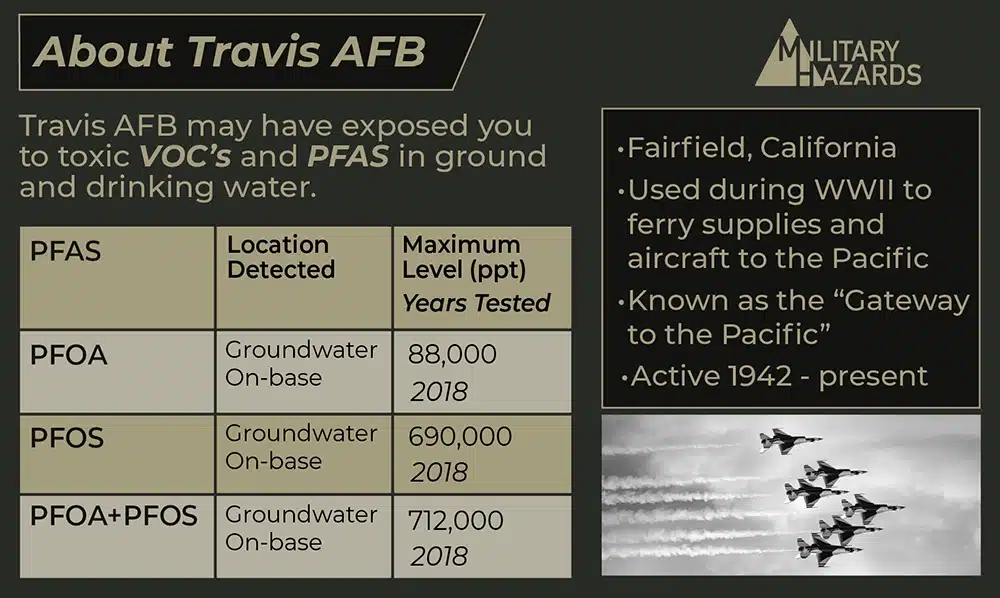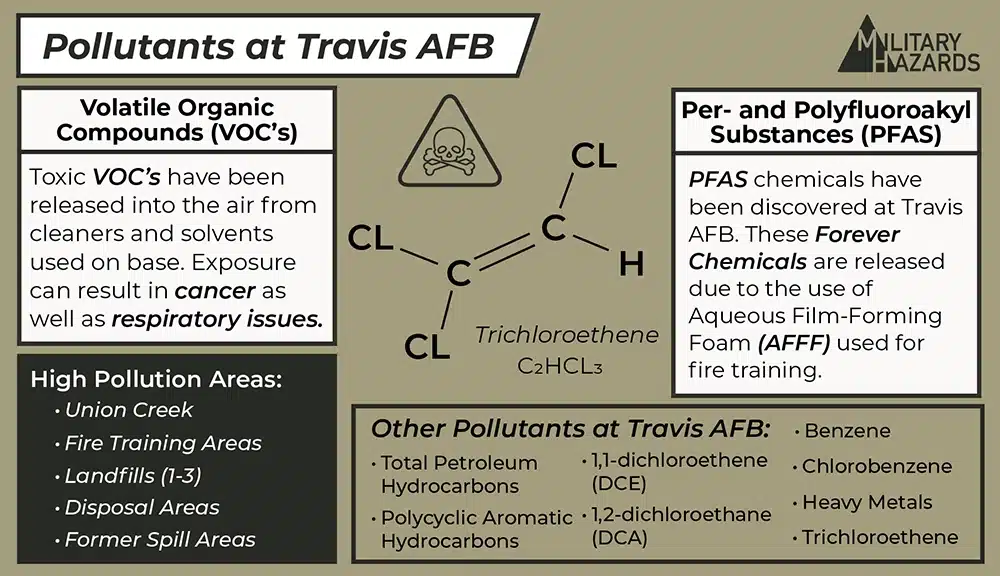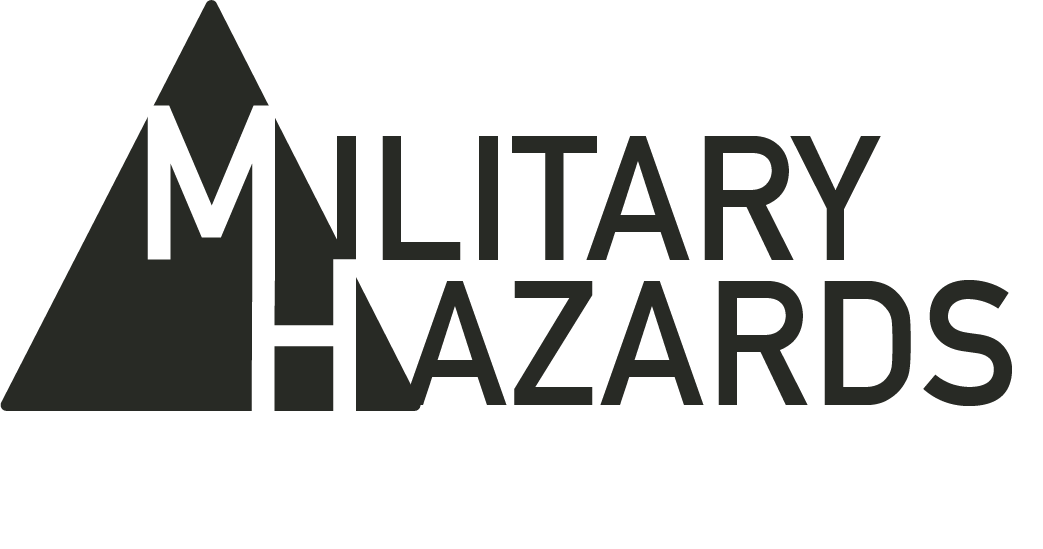Contact Our Legal Partner
"*" indicates required fields

Travis Air Force Base Water Contamination
Located in Fairfield, California, Travis Air Force Base encompasses over 6,300 acres. It is home to the 60th Air Mobility Wing and houses the C-5M Super Galaxy and C-17 Globemaster III aircraft. Originally operating as the Fairfield-Suisun Army Air Base during WWII, the installation would become a key logistics hub supporting critical personnel, aircraft, and operations around the world.
Over 10,000 active service members and 7,800 family members are stationed at or near Travis Air Force Base, but investigations show that the groundwater may be contaminated with per- and poly-fluoroalkyl substances (PFAS) as well as volatile organic compounds (VOCs). Clean-up efforts began in the early 1990s and continue today.
Individuals who were stationed at or near Travis Air Force Base for at least six months and were subsequently diagnosed with a condition related to PFAS exposure may be entitled to compensation. At MilitaryHazards.org, our team connects veterans with attorneys that have extensive experience handling military base water contamination lawsuits. Contact our office today to schedule a confidential consultation.

Updates for Travis AFB Water Contamination
May 2024: Investigations continue into the effects of PFAS exposure on humans and the environment. The EPA’s recommendation of reducing the health advisory level from 70 parts per trillion to 4 parts per trillion is expected to be made an enforceable requirement before the end of the year.
September 2023: A five-year review of federal facilities is completed as part of the clean-up efforts at Travis Air Force Base. Clean-up efforts have been in place since the early 1990s.
Early 2021: Installation of drinking water treatment systems was completed for residents living near Travis Air Force Base whose water was contaminated by high concentrations of PFAS.
June 2020: Investigations dating back to 2015 evidenced PFAS levels exceeding the U.S. Environmental Protection Agency’s (EPA’s) drinking water health advisory in the soil and groundwater at Travis Air Force Base. In June 2020, the investigations were expanded to off-site drinking water supply wells that were likely contaminated.
Travis Air Force Base and Its History of Toxic Chemicals
Travis Air Force Base was designated as a Superfund site in 1989. Since then, extensive efforts have been undertaken to investigate and remediate contaminated soil and groundwater near the military installation. The Air Force continues to work with the Environmental Protection Agency and other state regulatory agencies. They also established a Restoration Advisory Board in 1994 to allow for community input.
Volatile organic compounds (VOCs), metals, and polycyclic aromatic hydrocarbons (PAHs) were all discovered at the site in the 1990s as part of preliminary investigations. In 2015, extended investigations determined that levels of PFAS exceeded the EPA’s safety advisory levels. PFAS exposure has been linked to adverse health conditions and significant impacts to the environment.

Where Was There Contamination on Travis Air Force Base?
Dozens of sites in and around Travis Air Force Base have been identified as contaminated by the military. Contaminants at these sites include VOCs, PFAS, Total Petroleum Hydrocarbons (TPH), metals, polycyclic aromatic hydrocarbons (PAHs), and pesticides. Toxic chemicals have been detected in the soil, groundwater, surface water, and storm sewers throughout the base. Particular areas of concern include Union Creek, Fire Training Areas (1-4), Landfills (1-3), Disposal Areas, and Former Spill Areas.
What Water Contaminants Were Found on Travis Air Force Base?
The primary contaminants found in and around Travis Air Force Base include per- and poly-fluoroalkyl substances (PFAS) and volatile organic compounds (VOCs). To date over 15,000 pounds of VOCs have been removed from the military installation.
Other contaminants found in the soil and groundwater at Travis Air Force Base:
- Total Petroleum Hydrocarbons (TPH)
- Metals
- Polycyclic aromatic hydrocarbons (PAHs)
- Pesticides
- Trichloroethene (TCE)
- Benzene
- 1,2-dichloroethane (DCA)
- 1,1-dichloroethene (DCE)
- Chlorobenzene
Many of these substances pose serious health risks to humans and the environment upon exposure. Individuals who were stationed at Travis Air Force Base for at least six months may have unknowingly been exposed to contaminated water and are strongly encouraged to seek legal representation.

Is Travis Air Force Base Safe to Drink?
In 2015, an Air Force investigation determined that PFAS levels exceeded the EPA’s drinking water health advisory at the time, which was 70 parts per trillion. The EPA has since reduced its recommendations to PFAS levels of no more than 4 parts per trillion. In 2020, the Air Force expanded its investigation to include drinking water sites off-base. Again, PFAS levels exceeding the EPA’s health advisory recommendations were detected.
A PFAS snapshot released by the Department of Defense determined that the highest detection point of PFAS levels in off-base drinking water was 830 parts per trillion, over 10x the EPA’s initial recommendations. Groundwater sampling on the base detected PFAS levels of 712,000.
Advanced Water Treatment Efforts Conducted at the Base
The military has been engaged in extensive clean-up efforts throughout Travis Air Force Base for over nearly 30 years. The Department of Defense follows the Comprehensive Environmental Response, Compensation, and Liability Act (CERCLA) process for cleaning up sites with known contamination. Efforts include providing households affected by the toxic substances with water treatment systems, monitoring and sampling wells, and continuing to investigate how to eliminate the risk of exposure to humans and the environment.
What Health Risks Are Linked to Drinking Water at Travis Air Force Base?
There are a number of known health risks associated with exposure to water contaminated with PFAS, including an increased risk of cancer, thyroid disease, and other serious conditions. Individuals who were stationed at Travis Air Force Base are strongly encouraged to seek regular health check-ups and screenings to ensure early detection and treatment of any adverse health concerns.
Health risks and symptoms linked to drinking contaminated water:
- Male breast cancer
- Bladder cancer
- Low birth rates
- Preeclampsia
- Kidney cancer
- Thyroid disease
- Thyroid cancer
- Testicular cancer
- Hypertension
- Liver damage
- Infertility issues
Who Is Eligible to File a Travis Air Force Base Water Contamination Lawsuit?
To file a lawsuit based on water contamination at Travis Air Force Base, one must meet certain eligibility criteria. These criteria include proof of exposure to PFAS and other toxic chemicals and proof of diagnosis of a PFAS-related condition.
An experienced attorney can provide a legal evaluation to help determine whether you meet the qualifications necessary to file a claim. It is important to note that water contamination lawsuits may take several months to a year or more to complete. Working with a lawyer can help ensure that you meet all legal deadlines and help to give you realistic expectations about what to expect with your case.
Will There Be Settlements For Travis AFB Water Contamination Lawsuits?
Settlement and payout amounts for Travis Air Force Base water contamination lawsuits are expected to vary significantly depending on the circumstances of the case. However, previous cancer-related lawsuits often settled for between $100,000 and $300,000. The average settlement is expected to hover around $250,000.
Most settlements are anticipated to range between $30,000 and $500,000, with individuals who were younger at the time of diagnosis or who had extended duration of active illness receiving higher compensation. There is the potential for some cases to have values exceeding $1,000,000.
Claimants with minor injuries or less proof of connection to Travis Air Force Base’s toxic substances might see values between $30,000 and $75,000. While settlements are typically lower than potential trial verdicts, there is no guarantee of a successful outcome if the matter goes to trial.
How Can I File a Travis Air Force Base Water Contamination Lawsuit?
To file a Travis Air Force Base water contamination lawsuit, you will need to follow several steps. These steps can help to ensure that you meet all legal requirements and deadlines.
Steps for filing a Travis Air Force Base water contamination lawsuit:
- Determine eligibility. First, you will need to determine whether you meet the criteria necessary to file a claim. An attorney can provide a legal evaluation to help ensure you meet the qualifications.
- Collect evidence. Evidence often proves critical in a Travis Air Force Base water contamination lawsuit. Evidence may include medical records, military orders, environmental studies, and more.
- File the case. The next step in a water contamination lawsuit is filing the case. An attorney can help prepare the necessary documents and file them in the appropriate jurisdiction.
- Enter into negotiations. Once the case has been filed, your attorney can enter into negotiations. A settlement can be negotiated up until a verdict is reached.
- Prepare for trial. If a fair and full settlement cannot be reached, the matter will be set for trial. In general, verdicts are higher than potential settlements, but there is no guarantee of a favorable outcome.
What Evidence Is Needed for My Case?
In order to support your case, you will need to provide evidence. Evidence can help substantiate your claim.
Evidence that may prove important in your Travis Air Force Base water contamination case:
- Medical bills
- Military orders
- Environmental studies
- Proof of prescriptions
- Expert testimony
- CERCLA studies
- Sampling results
How Long Do I Have to File a Travis Air Force Base Water Contamination Claim?
Travis Air Force Base water contamination claims must be filed within the statute of limitations. A statute of limitations is a state-specific legal timeline. In order to qualify for compensation, victims must file their lawsuit within this specific timeframe.
In general, claimants have one to two years post-diagnosis to file a lawsuit. Some states, however, allow up to six years to file a case, particularly for PFAS-related illnesses. Due to the variations with statutes of limitations, urgent consultation with a lawyer is strongly advised.
Who Should Be My Water Contamination Lawyer?
Individuals who were stationed at Travis Air Force Base for six months or more and subsequently diagnosed with a PFAS-related condition may qualify for compensation. Our team has years of experience connecting servicemembers to lawyers handling military base lawsuits. They will help evaluate your claim, prepare documents, and represent you throughout the process. Contact our office now to schedule a consultation.
